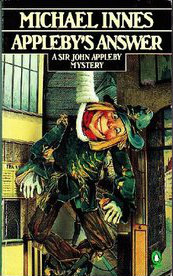Appleby’s Answer by Michael Innes
Review by Matt B. (BuffaloSavage)
Like Nicholas Blake, Cyril Hare, Mary Fitt and Josephine Tey, Michael Innes wrote mysteries with bookish people in mind. His vocabulary makes readers run to their dictionary: weedy, embrocation, and inamorato. Being a scholar of Shakespeare, his allusions are learned. His veddy English Dickensianism depends on farce, satire, faux pas, and zany characters in bizarre situations. All in all, a pleasure for hard-core readers, the kind of people who read Swift, Defoe, and Smollett for sheer pleasure.
This one opens with Innes’ poking gentle fun at mystery writers who write cozies like Murder in the Cathedral and Vengeance at the Vicarage. Authoress – steel yourself – Priscilla Pringle is gratified to spy a fellow train passenger reading one of her books. Her curiosity is quickened when the fellow passenger seeks her advice on how to commit murder, blackmail, and arson. She gets the feeling that the passenger indeed has nefarious plans. As the plot unfolds, lucky coincidence takes a hand and enter our series hero John Appleby.
Now a 60-year-old retiree of the Commissioner of Metropolitan Police, Appleby and sculptress wife Judith investigate what may be a complex criminal plot or silly damn malice. Published in 1973, this is very much a late entry in the canon, which began in 1936 with Seven Suspects (aka Death at the President’s Lodging). Appleby’s Answer is a novelette, which is okay with me. With age, I grow impatient with mysteries that seem more otiose the longer they are. New readers of Michael Innes would do better to test the early ones; fans of Innes – readers who want a break from Sterne and Fielding – will like regardless.







